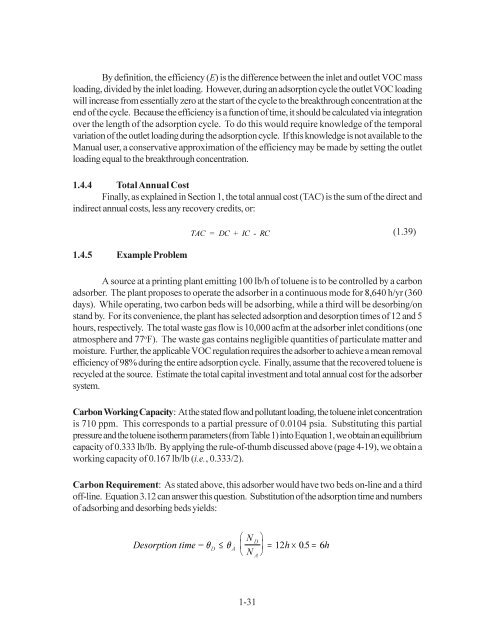Section 3 VOC Controls - US Environmental Protection Agency
Section 3 VOC Controls - US Environmental Protection Agency
Section 3 VOC Controls - US Environmental Protection Agency
Create successful ePaper yourself
Turn your PDF publications into a flip-book with our unique Google optimized e-Paper software.
By definition, the efficiency (E) is the difference between the inlet and outlet <strong>VOC</strong> mass<br />
loading, divided by the inlet loading. However, during an adsorption cycle the outlet <strong>VOC</strong> loading<br />
will increase from essentially zero at the start of the cycle to the breakthrough concentration at the<br />
end of the cycle. Because the efficiency is a function of time, it should be calculated via integration<br />
over the length of the adsorption cycle. To do this would require knowledge of the temporal<br />
variation of the outlet loading during the adsorption cycle. If this knowledge is not available to the<br />
Manual user, a conservative approximation of the efficiency may be made by setting the outlet<br />
loading equal to the breakthrough concentration.<br />
1.4.4 Total Annual Cost<br />
Finally, as explained in <strong>Section</strong> 1, the total annual cost (TAC) is the sum of the direct and<br />
indirect annual costs, less any recovery credits, or:<br />
1.4.5 Example Problem<br />
TAC = DC + IC - RC<br />
1-31<br />
(1.39)<br />
A source at a printing plant emitting 100 lb/h of toluene is to be controlled by a carbon<br />
adsorber. The plant proposes to operate the adsorber in a continuous mode for 8,640 h/yr (360<br />
days). While operating, two carbon beds will be adsorbing, while a third will be desorbing/on<br />
stand by. For its convenience, the plant has selected adsorption and desorption times of 12 and 5<br />
hours, respectively. The total waste gas flow is 10,000 acfm at the adsorber inlet conditions (one<br />
atmosphere and 77 o F). The waste gas contains negligible quantities of particulate matter and<br />
moisture. Further, the applicable <strong>VOC</strong> regulation requires the adsorber to achieve a mean removal<br />
efficiency of 98% during the entire adsorption cycle. Finally, assume that the recovered toluene is<br />
recycled at the source. Estimate the total capital investment and total annual cost for the adsorber<br />
system.<br />
Carbon Working Capacity: At the stated flow and pollutant loading, the toluene inlet concentration<br />
is 710 ppm. This corresponds to a partial pressure of 0.0104 psia. Substituting this partial<br />
pressure and the toluene isotherm parameters (from Table 1) into Equation 1, we obtain an equilibrium<br />
capacity of 0.333 lb/lb. By applying the rule-of-thumb discussed above (page 4-19), we obtain a<br />
working capacity of 0.167 lb/lb (i.e., 0.333/2).<br />
Carbon Requirement: As stated above, this adsorber would have two beds on-line and a third<br />
off-line. Equation 3.12 can answer this question. Substitution of the adsorption time and numbers<br />
of adsorbing and desorbing beds yields:<br />
Desorption time = θ ≤ θ<br />
D A<br />
⎛ N<br />
⎜<br />
⎝ N<br />
D<br />
A<br />
⎞<br />
⎟ = 12h × 05 .<br />
= 6h<br />
⎠

















